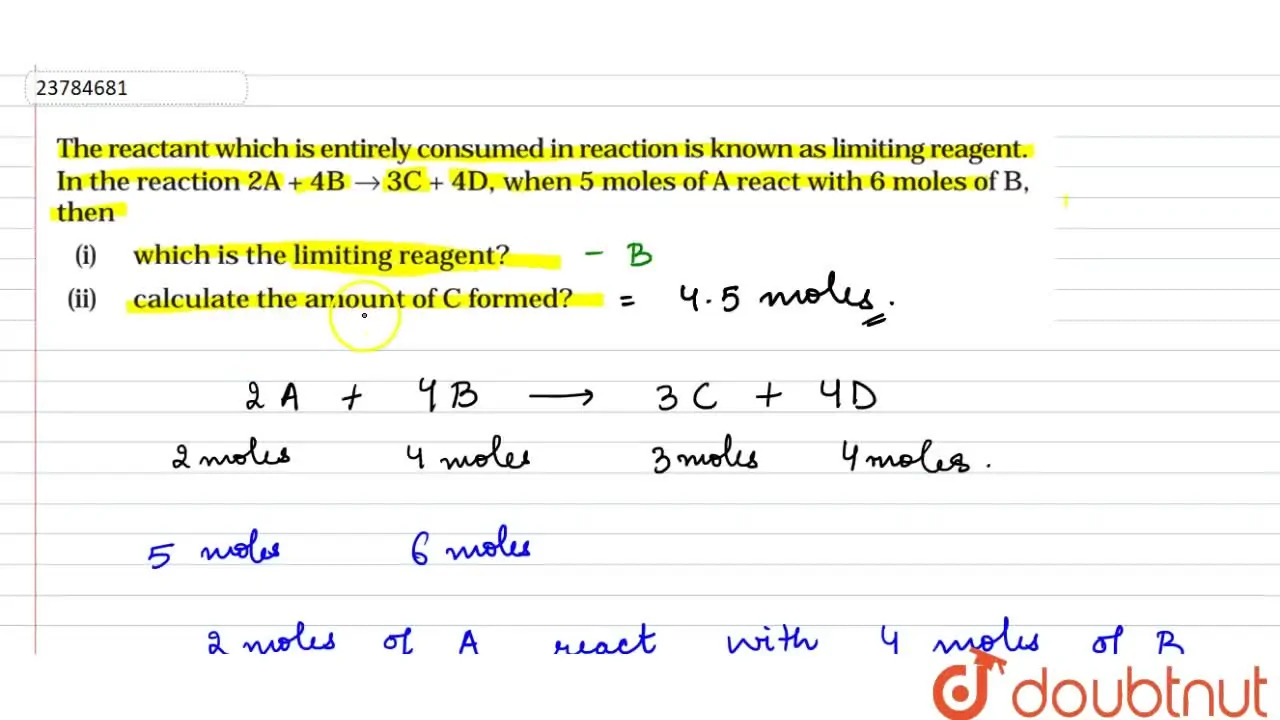The reactant which is entirely consumed in reaction is known as limiting reagent. In the reaction 2A+4B→3C+4D, when 5 moles of A react with 6 moles of B, then
(a) which is the limiting reagent?
(b) calculate the amount of C formed?
(i) The given reaction is :
2A(2 mol)+4B(4 mol)→3C(3mol)+4D(4 mol)
2 moles of A react with moles of B = 4
5 moles of A react with moles of B = 4
5 moles of A react with moles B=(5 mol)(2 mol)×4=10mol
But moles of B actually availble = 6 mol
(i) This means that B is the limiting reagent
(ii) Amount of C formed =(3 mol)(4 mol)×(6 mol)=4.5mol.
Related Playlists
- BOOK - DINESH PUBLICATIONCHAPTER - MOLE CONCEPTEXERCISE - N.C.E.R.T (Long answer)4videos
MOLE CONCEPT
- BOOK - DINESH PUBLICATIONCHAPTER - MOLE CONCEPTEXERCISE - Concept Based Question49videos
MOLE CONCEPT
- BOOK - DINESH PUBLICATIONCHAPTER - MOLE CONCEPTEXERCISE - Board Examinations35videos
MOLE CONCEPT
- BOOK - DINESH PUBLICATIONCHAPTER - HYDROGENEXERCISE - LONG1videos
HYDROGEN
- BOOK - DINESH PUBLICATIONCHAPTER - NOMENCLATURE OF ORGANIC COMPOUNDSEXERCISE - MCQs13videos
NOMENCLATURE OF ORGANIC COMPOUNDS
Similar Questions
The reactant which is entirely consumed in reaction is known as limiting reagent. In the reaction 2A+4B→3C+4D, when 5 moles of A react with 6 moles of B, then
(a) which is the limiting reagent?
(b) calculate the amount of C formed?View SolutionFor the reaction A + 2B → C, 5 moles of A and B moles of B will produce
View SolutionFor the reaction A+2B→C,5moles of A and 8moles of B will produce :-
View SolutionLimiting reagent in a chemical reaction is that reactant which
View SolutionFor the reaction :
7A+13B+15C⇒17P
If 15 moles of A, 26 moles of B and 30.5 moles of C are taken initially, then limiting reactant is:View Solution14 moles of A and 20 moles of B, 8 moles of C is formed in the following reaction 3A+4B→2C then.
View SolutionA: When 4 moles of H2 reacts with 2 moles of O2, then 4. moles of water is formed.
R: O2 will act as limiting reagent.View SolutionStatement-I : A reactant that is entirely consumed when a reaction goes to completion is known as limiting reactant.
Because
Statement-II : The amount of reactant limits the amount of product formed.View SolutionFor the reaction , A+3B→2C+d
which one of the following is not correct ?View SolutionFor reaction A+2B→C. The amount of C formed by starting the reaction with 5 mole of A and 8 mole of B is :
View Solution


